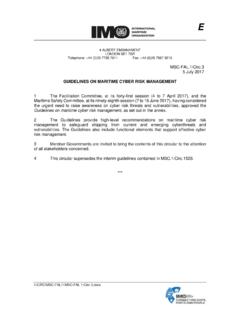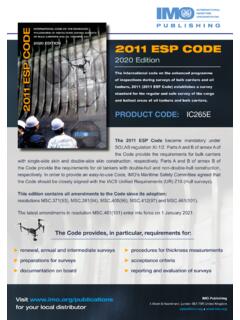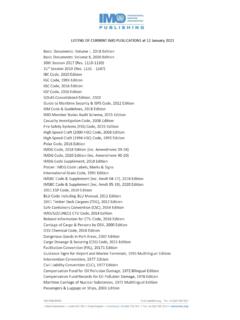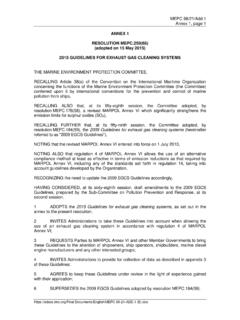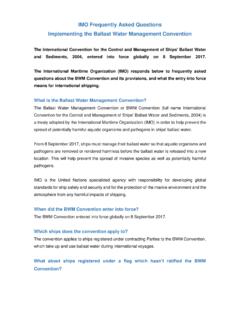Transcription of Resolution A.1045(27) Adopted on 30 November 2011 …
1 I:\ASSEMBLY\27\RES\ E ASSEMBLY 27th session Agenda item 9 A 27 December 2011 Original: ENGLISH Resolution (27) Adopted on 30 November 2011 (Agenda item 9) PILOT TRANSFER ARRANGEMENTS THE ASSEMBLY, RECALLING Article 15(j) of the Convention on the International Maritime Organization regarding the functions of the Assembly in relation to regulations and guidelines concerning maritime safety, NOTING the provisions of regulation V/23 of the International Convention for the Safety of Life at Sea (SOLAS), 1974, as amended, HAVING CONSIDERED the recommendation made by the Maritime Safety Committee at its eighty-seventh session, 1. ADOPTS the "Recommendation on Pilot Transfer Arrangements", as set out in the Annex to the present Resolution ; 2.
2 INVITES Governments to draw the attention of all concerned to this recommendation; 3. FURTHER INVITES Governments to ensure that mechanical pilot hoists are not used; 4. REQUESTS Governments to ensure that pilot ladders and their arrangements, use and maintenance conform to standards not inferior to those set out in the annex to the present Resolution ; 5. REVOKES Resolution (21). A 27 Page 2 I:\ASSEMBLY\27\RES\ Annex RECOMMENDATION ON PILOT TRANSFER ARRANGEMENTS 1 GENERAL Ship designers are encouraged to consider all aspects of pilot transfer arrangements at an early stage in design. Equipment designers and manufacturers are similarly encouraged, particularly with respect to the provisions of paragraphs , and 2 PILOT LADDERS A pilot ladder should be certified by the manufacturer as complying with this section or with the requirements of an international standard acceptable to the Position and construction The securing strong points, shackles and securing ropes should be at least as strong as the side ropes specified in section below.
3 The steps of the pilot ladders should comply with the following requirements: .1 if made of hardwood, they should be made in one piece, free of knots; .2 if made of material other than hardwood, they should be of equivalent strength, stiffness and durability to the satisfaction of the Administration; .3 the four lowest steps may be of rubber of sufficient strength and stiffness or other material to the satisfaction of the Administration; .4 they should have an efficient non-slip surface; .5 they should be not less than 400 mm between the side ropes, 115 mm wide and 25 mm in depth, excluding any non-slip device or grooving; .6 they should be equally spaced not less than 310 mm or more than 350 mm apart; and .7 they should be secured in such a manner that each will remain horizontal.
4 No pilot ladder should have more than two replacement steps which are secured in position by a method different from that used in the original construction of the ladder, and any steps so secured should be replaced as soon as reasonably practicable by steps secured in position by the method used in the original construction of the pilot ladder. When any replacement step is secured to the side ropes of the pilot ladder by means of grooves in the sides of the step , such grooves should be in the longer sides of the step . 1 Refer to the recommendations by the International Organization for Standardization, in particular publication ISO 799:2004, Ships and marine technology Pilot ladders.
5 A 27 Page 3 I:\ASSEMBLY\27\RES\ Pilot ladders with more than five steps should have spreader steps not less than m long provided at such intervals as will prevent the pilot ladder from twisting. The lowest spreader step should be the fifth step from the bottom of the ladder and the interval between any spreader step and the next should not exceed nine steps. When a retrieval line is considered necessary to ensure the safe rigging of a pilot ladder, the line should be fastened at or above the last spreader step and should lead forward. The retrieval line should not hinder the pilot nor obstruct the safe approach of the pilot boat. A permanent marking should be provided at regular intervals ( 1 m) throughout the length of the ladder consistent with ladder design, use and maintenance in order to facilitate the rigging of the ladder to the required height.
6 Ropes The side ropes of the pilot ladder should consist of two uncovered ropes not less than 18 mm in diameter on each side and should be continuous, with no joints and have a breaking strength of at least 24 Kilo Newtons per side rope. The two side ropes should each consist of one continuous length of rope, the midpoint half-length being located on a thimble large enough to accommodate at least two passes of side rope. Side ropes should be made of manila or other material of equivalent strength, durability, elongation characteristics and grip which has been protected against actinic degradation and is satisfactory to the Administration.
7 Each pair of side ropes should be secured together both above and below each step with a mechanical clamping device properly designed for this purpose, or seizing method with step fixtures (chocks or widgets), which holds each step level when the ladder is hanging freely. The preferred method is 3 ACCOMMODATION LADDERS USED IN CONJUNCTION WITH PILOT LADDERS Arrangements which may be more suitable for special types of ships may be accepted, provided that they are equally safe. The length of the accommodation ladder should be sufficient to ensure that its angle of slope does not exceed 45 . In ships with large draft ranges, several pilot ladder hanging positions may be provided, resulting in lesser angles of slope.
8 The accommodation ladder should be at least 600 mm in width. The lower platform of the accommodation ladder should be in a horizontal position and secured to the ship's side when in use. The lower platform should be a minimum of 5 m above sea level. Intermediate platforms, if fitted, should be self-levelling. Treads and steps of the accommodation ladder should be so designed that an adequate and safe foothold is given at the operative angles. Refer to the recommendations by the International Organization for Standardization, in particular publication ISO 799:2004, Ships and marine technology Pilot ladders, part and part 3, paragraph A 27 Page 4 I:\ASSEMBLY\27\RES\ The ladder and platform should be equipped on both sides with stanchions and rigid handrails, but if handropes are used they should be tight and properly secured.
9 The vertical space between the handrail or handrope and the stringers of the ladder should be securely fenced. The pilot ladder should be rigged immediately adjacent to the lower platform of the accommodation ladder and the upper end should extend at least 2 m above the lower platform. The horizontal distance between the pilot ladder and the lower platform should be between and m. If a trapdoor is fitted in the lower platform to allow access from and to the pilot ladder, the aperture should not be less than 750 mm x 750 mm. The trapdoor should open upwards and be secured either flat on the embarkation platform or against the rails at the aft end or outboard side of the platform and should not form part of the handholds.
10 In this case the after part of the lower platform should also be fenced as specified in paragraph above, and the pilot ladder should extend above the lower platform to the height of the handrail and remain in alignment with and against the ship's side. Accommodation ladders, together with any suspension arrangements or attachments fitted and intended for use in accordance with this recommendation, should be to the satisfaction of the Administration3. 4 MECHANICAL PILOT HOISTS The use of mechanical pilot hoists is prohibited by SOLAS regulation V/23. 5 ACCESS TO DECK Means should be provided to ensure safe, convenient and unobstructed passage for any person embarking on, or disembarking from, the ship between the head of the pilot ladder, or of any accommodation ladder, and the ship's deck; such access should be gained directly by a platform securely guarded by handrails.


